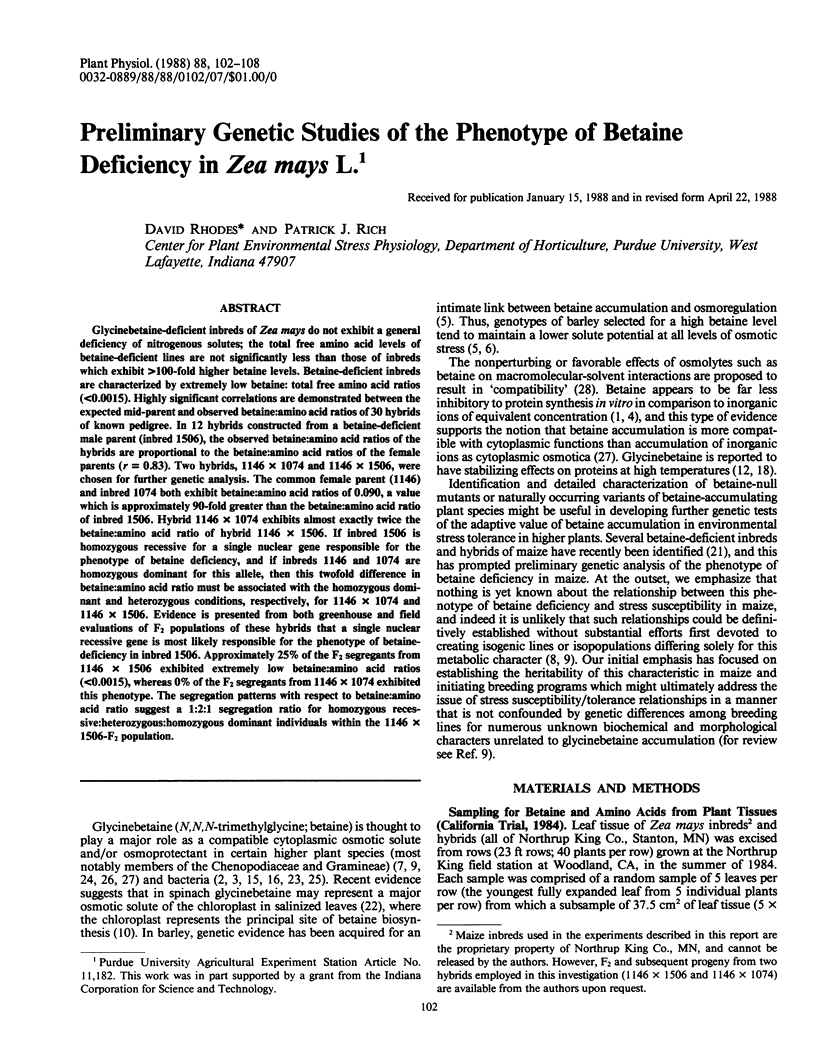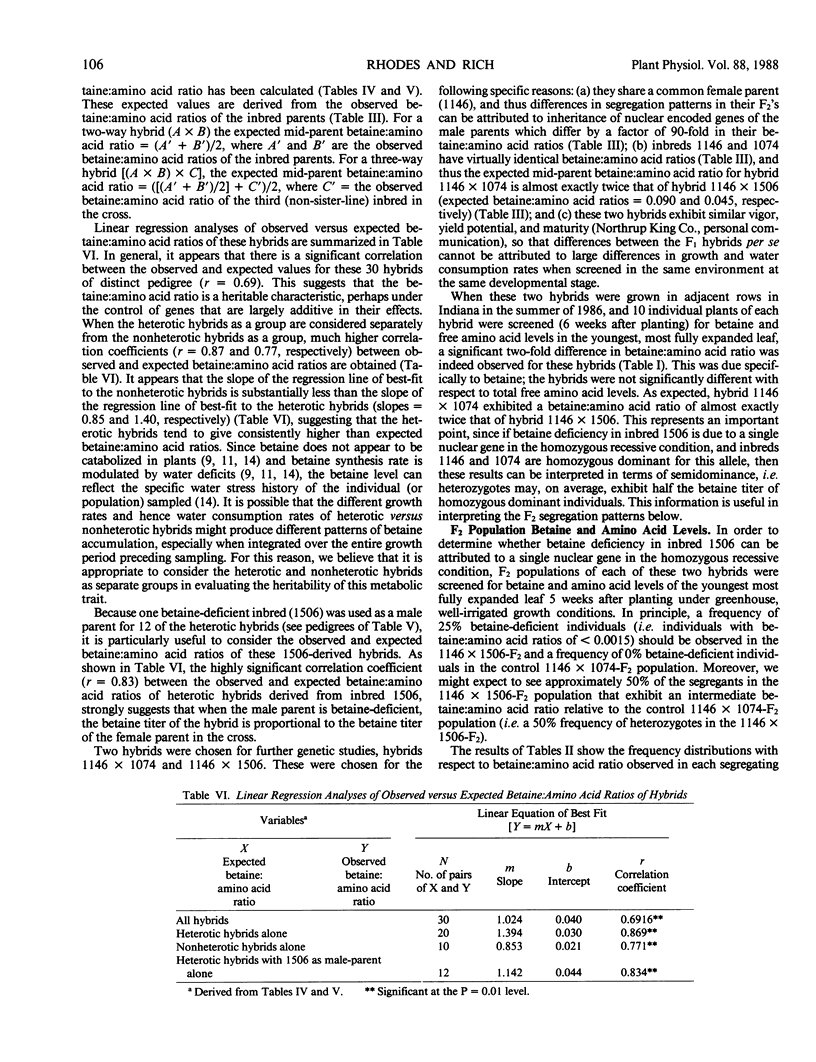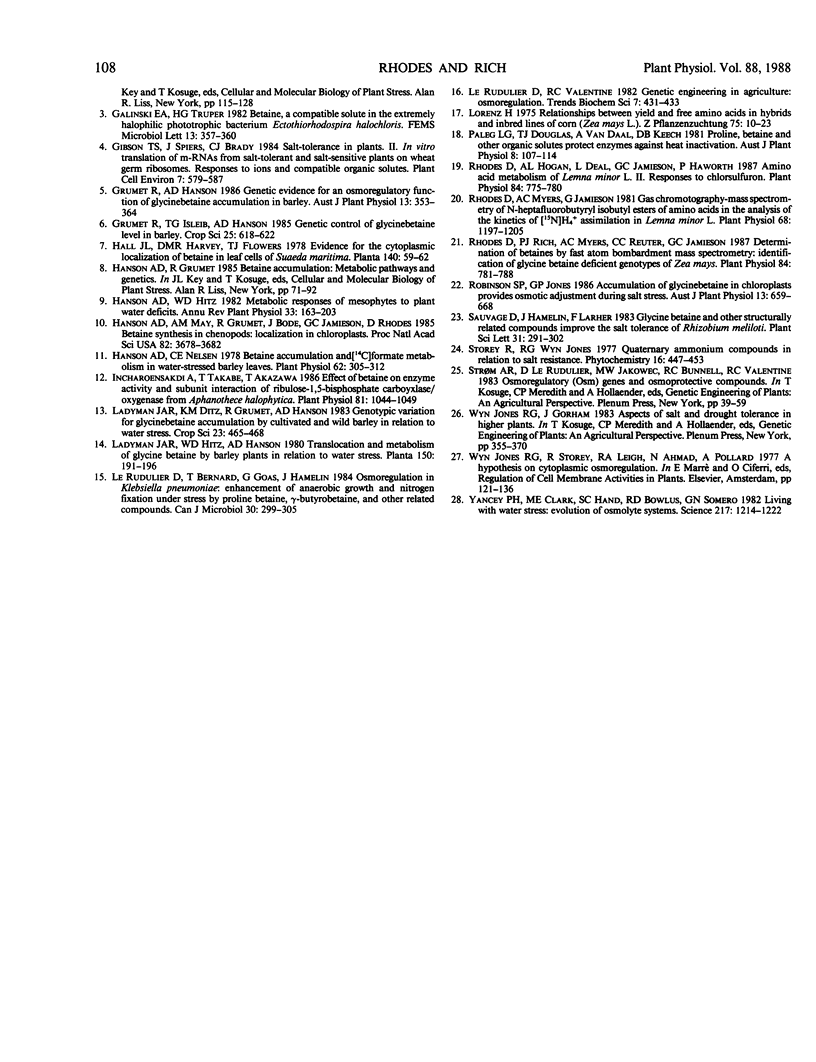Abstract
Glycinebetaine-deficient inbreds of Zea mays do not exhibit a general deficiency of nitrogenous solutes; the total free amino acid levels of betaine-deficient lines are not significantly less than those of inbreds which exhibit >100-fold higher betaine levels. Betaine-deficient inbreds are characterized by extremely low betaine: total free amino acid ratios (<0.0015). Highly significant correlations are demonstrated between the expected mid-parent and observed betaine:amino acid ratios of 30 hybrids of known pedigree. In 12 hybrids constructed from a betaine-deficient male parent (inbred 1506), the observed betaine:amino acid ratios of the hybrids are proportional to the betaine:amino acid ratios of the female parents (r = 0.83). Two hybrids, 1146 × 1074 and 1146 × 1506, were chosen for further genetic analysis. The common female parent (1146) and inbred 1074 both exhibit betaine:amino acid ratios of 0.090, a value which is approximately 90-fold greater than the betaine:amino acid ratio of inbred 1506. Hybrid 1146 × 1074 exhibits almost exactly twice the betaine:amino acid ratio of hybrid 1146 × 1506. If inbred 1506 is homozygous recessive for a single nuclear gene responsible for the phenotype of betaine deficiency, and if inbreds 1146 and 1074 are homozygous dominant for this allele, then this twofold difference in betaine:amino acid ratio must be associated with the homozygous dominant and heterozygous conditions, respectively, for 1146 × 1074 and 1146 × 1506. Evidence is presented from both greenhouse and field evaluations of F2 populations of these hybrids that a single nuclear recessive gene is most likely responsible for the phenotype of betaine-deficiency in inbred 1506. Approximately 25% of the F2 segregants from 1146 × 1506 exhibited extremely low betaine:amino acid ratios (<0.0015), whereas 0% of the F2 segregants from 1146 × 1074 exhibited this phenotype. The segregation patterns with respect to betaine:amino acid ratio suggest a 1:2:1 segregation ratio for homozygous recessive:heterozygous:homozygous dominant individuals within the 1146 × 1506-F2 population.
Full text
PDF






Selected References
These references are in PubMed. This may not be the complete list of references from this article.
- Hanson A. D., May A. M., Grumet R., Bode J., Jamieson G. C., Rhodes D. Betaine synthesis in chenopods: Localization in chloroplasts. Proc Natl Acad Sci U S A. 1985 Jun;82(11):3678–3682. doi: 10.1073/pnas.82.11.3678. [DOI] [PMC free article] [PubMed] [Google Scholar]
- Hanson A. D., Nelsen C. E. Betaine Accumulation and [C]Formate Metabolism in Water-stressed Barley Leaves. Plant Physiol. 1978 Aug;62(2):305–312. doi: 10.1104/pp.62.2.305. [DOI] [PMC free article] [PubMed] [Google Scholar]
- Incharoensakdi A., Takabe T., Akazawa T. Effect of Betaine on Enzyme Activity and Subunit Interaction of Ribulose-1,5-Bisphosphate Carboxylase/Oxygenase from Aphanothece halophytica. Plant Physiol. 1986 Aug;81(4):1044–1049. doi: 10.1104/pp.81.4.1044. [DOI] [PMC free article] [PubMed] [Google Scholar]
- Le Rudulier D., Bernard T., Goas G., Hamelin J. Osmoregulation in Klebsiella pneumoniae: enhancement of anaerobic growth and nitrogen fixation under stress by proline betaine, gamma-butyrobetaine, and other related compounds. Can J Microbiol. 1984 Mar;30(3):299–305. doi: 10.1139/m84-045. [DOI] [PubMed] [Google Scholar]
- Rhodes D., Hogan A. L., Deal L., Jamieson G. C., Haworth P. Amino Acid Metabolism of Lemna minor L. : II. Responses to Chlorsulfuron. Plant Physiol. 1987 Jul;84(3):775–780. doi: 10.1104/pp.84.3.775. [DOI] [PMC free article] [PubMed] [Google Scholar]
- Rhodes D., Myers A. C., Jamieson G. Gas Chromatography-Mass Spectrometry of N- Heptafluorobutyryl Isobutyl Esters of Amino Acids in the Analysis of the Kinetics of [N]H(4) Assimilation in Lemna minor L. Plant Physiol. 1981 Nov;68(5):1197–1205. doi: 10.1104/pp.68.5.1197. [DOI] [PMC free article] [PubMed] [Google Scholar]
- Rhodes D., Rich P. J., Myers A. C., Reuter C. C., Jamieson G. C. Determination of Betaines by Fast Atom Bombardment Mass Spectrometry : Identification of Glycine Betaine Deficient Genotypes of Zea mays. Plant Physiol. 1987 Jul;84(3):781–788. doi: 10.1104/pp.84.3.781. [DOI] [PMC free article] [PubMed] [Google Scholar]
- Yancey P. H., Clark M. E., Hand S. C., Bowlus R. D., Somero G. N. Living with water stress: evolution of osmolyte systems. Science. 1982 Sep 24;217(4566):1214–1222. doi: 10.1126/science.7112124. [DOI] [PubMed] [Google Scholar]


